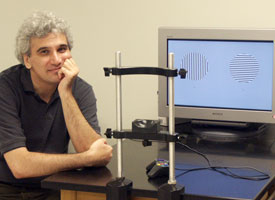For years, scientists have been exploring the large portions of the brain that correlate to vision.
Their efforts have led to a well-documented understanding of one portion of the visual system—the neural wiring that conveys information from each retina to early visual areas in the brain. However, understanding what happens later in the visual process is left unknown.
“How information is represented in different areas of the brain is one of the fundamental puzzles in cognitive neuroscience,” said Haluk Ogmen, a professor of electrical and computer engineering at the University of Houston Cullen College of Engineering. “The eye is camera-like and generates a two-dimensional image of a stimulus on the retina. This image-like representation, known as retinotopic representation, is preserved in the early parts of the visual system, but the geometry of how things are represented later in the brain is a mystery.”
So Ogmen is using roughly $500,000 in grant funding received last month from the National Institutes of Health to pinpoint exactly how the objects we see are represented in higher levels of the brain. Fully understanding how the brain processes the objects a person sees, he believes, could be a key to unraveling some of the mystery surrounding just how the three-pound mass works.
“It is well established that retinotopic representations are neither sufficient nor necessary to support our visual perception,” Ogmen said. “This is because when we view a scene, our eyes and many objects are in motion. A retinotopic representation would imply that the environment should appear highly blurred, contrary to our day-to-day experience. Thus, the puzzle that remains to be solved is to understand how information is represented in the higher parts of the brain to support the clarity of our perception.”
Throughout the next two years of support, Ogmen will work with co-investigator, Harold Bedell from the UH College of Optometry. Together, the two researchers have developed a series of psychophysical experiments designed to shed light on visual perception.
The tests, projected onto a computer screen in front of participants, consist of short clips that are carefully designed to induce illusions of motion. Participants must indicate, with a joystick, an aspect of their perception such as the direction an object is moving on the screen.
Using the data collected, the two researchers will develop a mathematical model to interpret the findings in order to characterize information representation beyond the early, retinotopic vision areas.
“Anatomical studies reveal the physical layout of the brain, but we need to also understand the functional layout of the brain, or how information is represented and processed in different parts of the brain,” he said. “We hope that these studies will lead to an understanding of higher areas of the visual system.”
